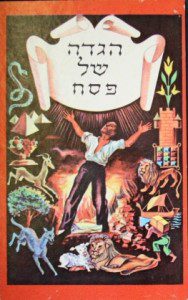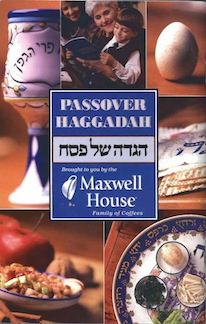
Every year on Passover, between sculpting matzo balls and hunting for unspotted linens, I go on a panicky search for our pack of Haggadahs, the narrative that guides Jews through the ritual Seder meal. If you canvas Jews you’ll find about as many varieties of the 10th-century text as there are recipes for perfect brisket. Uniting Jewish people from across the world and the ages, the annual “telling” (literal translation of Haggadah) of the story of Passover through prayers, poetry and song is meant to remind Jews of the Exodus, a powerful metaphor for liberation that can resonate on all sorts of levels – political, spiritual, personal. Unlike standard liturgies for other key religious holidays such as Rosh Hashanah, the Haggadah is famously elastic and moldable to different communitiy and individual needs. As such, there are Haggadahs of all kinds – feminist, literary, interfaith and interracial, LGBT, Buddhist, and more.
 Sometimes I’m lucky enough to find a few of the Haggadahs that my family’s been using for decades – the Maxwell House versions that date back to 1932. But usually I give up and begin Googling madly to piece together something customized for my semi-secular and interfaith gathering. Last year our Haggadah revolved around a single quote by the Dalai Lama about how compassion delivers us from isolation. Between hitting all the marks of a traditional seder – from the four questions to the afikomen, with copious amounts of wine in between – our group had a lively discussion about the meaning of Exodus that also included writings they brought.
Sometimes I’m lucky enough to find a few of the Haggadahs that my family’s been using for decades – the Maxwell House versions that date back to 1932. But usually I give up and begin Googling madly to piece together something customized for my semi-secular and interfaith gathering. Last year our Haggadah revolved around a single quote by the Dalai Lama about how compassion delivers us from isolation. Between hitting all the marks of a traditional seder – from the four questions to the afikomen, with copious amounts of wine in between – our group had a lively discussion about the meaning of Exodus that also included writings they brought.
This year I’m hacking the Haggadah again: collaging together a text from books and the Internet that captures the beautiful spirit of the ritual as I see it. At least the way I see it this year. Here’s my GPS to some sources and resources in print and online.
Every year there’s a new crop of print Haggadahs. This year’s range from the family-friendly to the ponderous. As a mom with a bad memory, I appreciate Melissa Berg’s linear, super-graphic Pop Haggadah. The bold illustrations, à la Colorforms and Milton Glaser, accompany traditional text (in English and Hebrew) and fun sidebars, like the one showing a chemical structure with a caption that reads: “Reseveratol: An antioxidant found in grapes, believed to have many health benefits.” Important information for young people. I could extract a few of these fun facts for my own Haggadah.
 Jonathan Safran Foer’s New American Haggadah combines verse, abstract watercolors, wacky text compositions and timelines with cool Passover-related facts that I would like to lift, like “900 AD: In a handwritten scrawl, an anonymous Palestinian Jew composes a Haggadah, now one of the oldest known surviving versions on earth.” It was just released in paperback this year, available in a Seder-handy 5-pack collection.
Jonathan Safran Foer’s New American Haggadah combines verse, abstract watercolors, wacky text compositions and timelines with cool Passover-related facts that I would like to lift, like “900 AD: In a handwritten scrawl, an anonymous Palestinian Jew composes a Haggadah, now one of the oldest known surviving versions on earth.” It was just released in paperback this year, available in a Seder-handy 5-pack collection.
Escape Velocity, A post-Apocalyptic Passover Haggadah by the author/illustrator Stanley Aaron Lebovic is an existential extravaganza. At 4 lbs, with 60 illustrations,, and a 3-foot pullout section, the 200-page tome addresses the Seder night as “the battleground where man’s stare must penetrate his own heart, and without missing a beat his heart must courageously return the gaze.” In contrast, the expedient The Sixty-Minute Haggadah by Nellie and Cass Foster takes readers step-by-step from the pre-Seder preparation to a truncated service, with recipes for the 8 unleavened days.
I very much like some elements of The Bronfman Haggadah, by the Jewish philanthropist Edgar F. Bronfman, who passed this year, such as the play-like telling of the story of Exodus, the biblical map, and illustrations by his wife, the artist Jan Aronson. Traditionalists, be warned: Bronfman replaces the anthropomorphic God with “an energy that is both transcendent (beyond us) and immanent (within us.)”
To find even more “Om in Shalom,” as Ellen Frankel put it, see her piece in Huffington Post on the similarities between the two groups. There’s also “Haggadah for Jews and Buddhists” which links the traditional retelling with Buddhist concepts.
 Some Haggadah hackers might want the help of online Haggadah-building websites, like haggadot.com and Diptwice.com which let you populate traditional or liberal templates with clips from their library of prayers, commentary, music, videos, recipes, etc. Or consider the downloadable themed Haggadahs at Religious Action Center of Reform Judaism, including the Black-Jewish Haggadahm the Labor Union Haggadah to the Earth Seder Haggadah. Jewish Queers International also puts out an LGBT Passover Haggadah.
Some Haggadah hackers might want the help of online Haggadah-building websites, like haggadot.com and Diptwice.com which let you populate traditional or liberal templates with clips from their library of prayers, commentary, music, videos, recipes, etc. Or consider the downloadable themed Haggadahs at Religious Action Center of Reform Judaism, including the Black-Jewish Haggadahm the Labor Union Haggadah to the Earth Seder Haggadah. Jewish Queers International also puts out an LGBT Passover Haggadah.
Political and social activists can reach into many wells to fill their Seder glasses. Consider a collection of phrases by inspiring leaders, such as Nelson Mandela, who wrote “For to be free is not merely to cast off one’s chains, but to live in a way that respects and enhances the freedom of others.” Or Martin Luther King’s speeches. You could construct an entire evening around his “I have a dream” speech. I mean, really:
…when we allow freedom ring, when we let it ring from every village and every hamlet, from every state and every city, we will be able to speed up that day when all of God’s children, black men and white men, Jews and Gentiles, Protestants and Catholics, will be able to join hands and sing in the words of the old Negro spiritual: Free at last! Free at last! Thank God Almighty, we are free at last.
 Last year Elie Wiesel, the Nobel Laureate and holocaust survivor, issued the “A Passover Haggadah” iBook. He recounts the last Seder in his German-occupied village in the Carpathian Mountains with the sounds of bombs in the background, praying to be saved – an emotional read. Each year the Jewish Foundation for the Righteous issues a downloadable Haggadah Supplement honoring those who risked their lives to rescue Jews during the Holocaust. “Just as we tell of Moses leading our people to freedom, at our Seder we also tell of contemporary heroes and how they led Jews to their freedom more than sixty-five years ago.” The supplements are read after the end-of-Seder singing of Dayyenu (it would have been enough.)
Last year Elie Wiesel, the Nobel Laureate and holocaust survivor, issued the “A Passover Haggadah” iBook. He recounts the last Seder in his German-occupied village in the Carpathian Mountains with the sounds of bombs in the background, praying to be saved – an emotional read. Each year the Jewish Foundation for the Righteous issues a downloadable Haggadah Supplement honoring those who risked their lives to rescue Jews during the Holocaust. “Just as we tell of Moses leading our people to freedom, at our Seder we also tell of contemporary heroes and how they led Jews to their freedom more than sixty-five years ago.” The supplements are read after the end-of-Seder singing of Dayyenu (it would have been enough.)
The feminist in you might invite the prophetess Miriam to your table. She was Moses’ sister who is said to have nurtured the Israelites throughout their journey across the desert with a well that followed. Your table could include “Miriam’s cup” filled with water, to represent Miriam’s well. For more ideas, you can mine the many feminist Haggadot online for inspiration, such as Eszter’s Passover page, or borrow rituals from the feminist E.M. Broner, who started the “Seder Sisters” in 1976 and has been adapting it for decades. Her Passover Seders have featured an empty chair not for Elijah, but for Bella Abzug – with a big flowered hat. On the Passover page of the Jewish Feminist magazine Lilith.com, you’ll also find ways to give Passover a feminist twist.
I always supplement my evening with a favorite verse. How perfectly does this epigrammatic Emily Dickinson poem express the idea that freedom lives within us all?
No Prisoner be –
Where Liberty –
Himself – Abide with Thee.
 One of my favorite poems by Louise Gluck, The Wild Iris, is a beautiful expression of liberty and renewal. It begins “At the end of my suffering/there was a door” and ends:
One of my favorite poems by Louise Gluck, The Wild Iris, is a beautiful expression of liberty and renewal. It begins “At the end of my suffering/there was a door” and ends:
You who do not remember
passage from the other world
I tell you I could speak again: whatever
Returns from oblivion returns to find a voice:
From the center of life came
A great fountain, deep blue
Shadows on azure seawater.
Some sources for poetry include Academy of American Poets, where you can browse by poem, title, author or keyword, and poemhunter.org, which supplies a list of keywords, like “freedom.”
With such an abundance of online options available, I’m thinking it might just be easier to ask guests to cut their ringers – but keep their devices handy.




